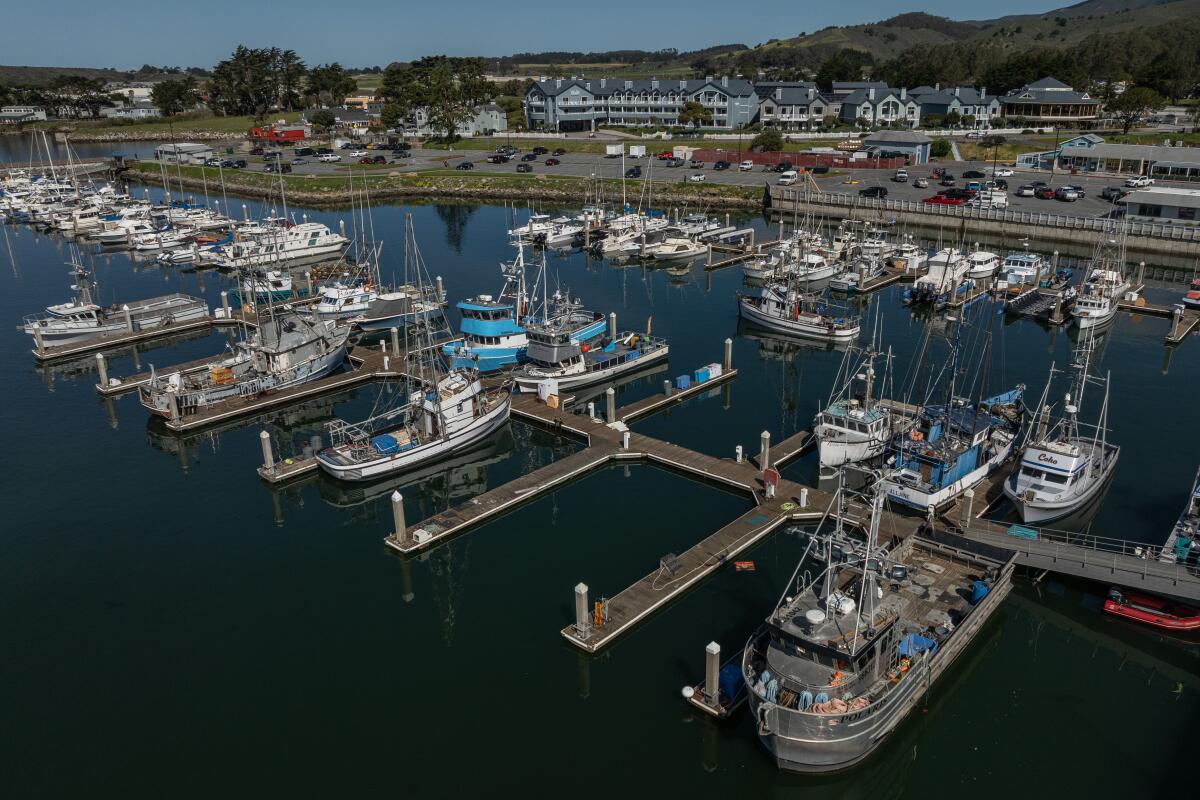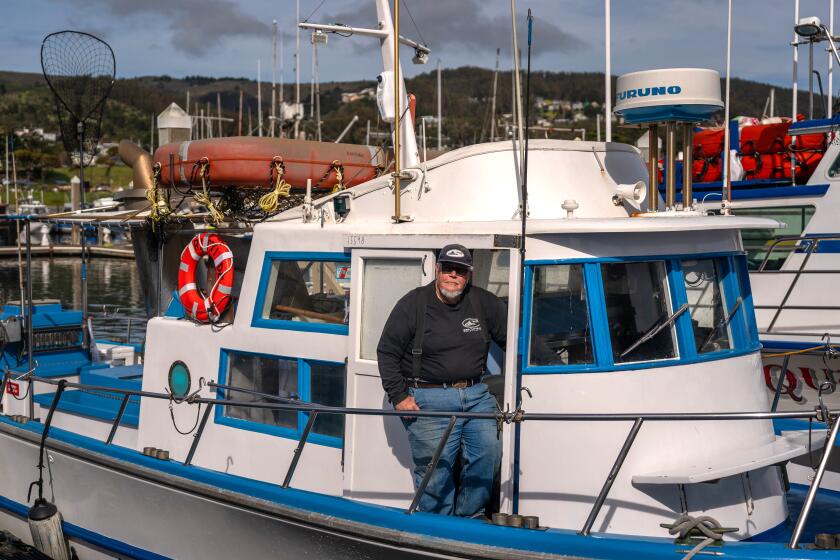Coastal salmon fishing banned for a second year amid steep population declines

- Share via
With salmon populations struggling, fishery officials have decided to ban fishing along the California coast for a second straight year.
The Pacific Fishery Management Council, a multi-state, quasi-federal body that decides on ocean fishing seasons, voted unanimously Wednesday to recommend shutting down commercial and recreational fishing along the coast.
Chinook salmon populations have suffered major declines in recent years, and fishery managers decided to prohibit fishing for another year to help stocks recover.
“A lot of people have already been hurting because of last year’s shutdown,” said Scott Artis, executive director of Golden State Salmon Assn. “And this is just going to be one more devastating blow.”
Aggressive and impactful reporting on climate change, the environment, health and science.
California’s commercial salmon fishing fleet now numbers about 460 vessels, Artis said, and many in the business have recently turned to other work to make ends meet. Others who take groups out on charter boats for recreational fishing will also be forced to find other business for another year.
It’s the second time in California history that coastal fishing has been prohibited for two consecutive years. The other back-to-back closure occurred in 2008 and 2009.
In both cases, the cancellation of fishing came a few years after severe drought.
“After the closure last year, this decision is not an easy one to make,” said Charlton “Chuck” Bonham, director of the California Department of Fish and Wildlife. “While we have been enjoying back-to-back rainy and wet winters this year and last, the salmon that will benefit from these conditions aren’t expected to return to California until around 2026 or 2027.”
Bonham said the salmon “were impacted by the difficult environmental factors present three to five years ago.”

In an announcement of the closure, the Department of Fish and Wildlife said salmon stocks “continue to be impacted in California from ongoing issues associated with drought and climate disruption.”
The agency said low numbers of returning adult salmon last year — as well as low ocean population forecasts — led the Pacific Fishery Management Council to recommend full closure of ocean salmon fisheries.
Captains of fishing boats on the California coast are bracing for salmon fishing to be severely restricted — or possibly canceled for a second year.
The fishing season for fall-run chinook salmon would normally run from about May to October.
The National Marine Fisheries Service is expected to act on the council’s recommendation and enact the closure.
The council also recommended that the California Fish and Game Commission close down inland fishing for salmon on the state’s rivers at a meeting next month.
Many who work in the fishing industry have said they blame California water managers for the low salmon numbers, saying too much water has been sent to farms and cities, depriving rivers of the cold flows salmon need to survive.
Artis, whose group represents fishing communities, blamed Gov. Gavin Newsom and his administration.
“We’ve seen that under Gov. Newsom, the state of California has had a disastrous environmental record,” Artis said. “Dangerously low river flows, unsustainable water diversions have been happening out of our rivers.”
California’s fishing fleet suffered when salmon fishing was banned last year. With the fish population still struggling, more fishing restrictions are expected.
He also criticized the amounts of water going to the state’s agriculture industry, saying that California has seen a dramatic expansion of “insatiably thirsty almond acreage” in recent years, and that the water the salmon industry relies on is being “stolen on Gov. Newsom’s watch.”
State officials say they are prioritizing plans to help salmon populations recover. Newsom’s administration in January announced a salmon strategy plan including a series of expanded efforts, including restoring habitats, modernizing hatcheries and removing barriers that block fish migration.
Bonham has said that even as the fishery goes through this difficult time, state officials are focused on actions that can “change the trajectory.” He said these efforts include restoring wetlands to create more habitat, removing dams on the Klamath River and protecting flows and water quality in rivers to support fish.
“Hope is very much alive for salmon in California,” Bonham said in a recent interview with The Times. “We think they can not only hang on in the state but thrive, and get back to healthy numbers each year, where people can enjoy them.”
California rivers once teemed with salmon, but the construction of dams blocked the fish from reaching many of the cold mountain streams where they once spawned. For decades, government-run hatcheries have reared and released millions of salmon each year. Those efforts, however, haven’t been enough to prevent populations from declining.
Successive droughts and global warming have also taken a toll. During the 2020-22 drought, the water flowing from dams sometimes got so warm that it was lethal for salmon eggs.
“There is no way that we can sugarcoat this or just lay the blame solely on drought. This really is a water policy problem. And it’s just compounded by drought and climate change,” Artis said. “If we want to save this industry in the long term, and save the species in the long term, we need to make some changes now on our water policy.”
Environmental groups are urging water managers to scale back pumping until juvenile salmon and steelhead have finished migrating through the delta and into San Francisco Bay.
The Pacific Coast Federation of Fishermen’s Assns., the largest commercial fishing trade association on the West Coast, supported the closure. George Bradshaw, the federation’s president, said that although the shutdown is painful for fishing communities, “we all need to be doing everything we can to give California’s salmon a chance to recover.”
Salmon are also central to the cultures of Native tribes, whose leaders canceled subsistence fishing last year.
Regina Chichizola, of the group Save California Salmon, said the closure is devastating for those who depend on fishing. She called it a “manmade disaster” and said it’s linked to decisions by the Biden administration and the state government to continue with water operations that “prioritize water for agriculture over salmon, cities and communities.”
The federal government has announced $20.6 million in disaster relief funds for California fishing communities affected by last year’s shutdown. But the funds have yet to be distributed. The Department of Fish and Wildlife said it is accepting comments from the public on the plan for spending the relief funds.
In response to the closure, Newsom announced Thursday that he had requested a federal declaration of a fishery disaster, much as he did last year. If approved, the disaster declaration would provide needed relief to impacted communities.
Toward a more sustainable California
Get Boiling Point, our newsletter exploring climate change, energy and the environment, and become part of the conversation — and the solution.
You may occasionally receive promotional content from the Los Angeles Times.











